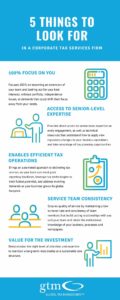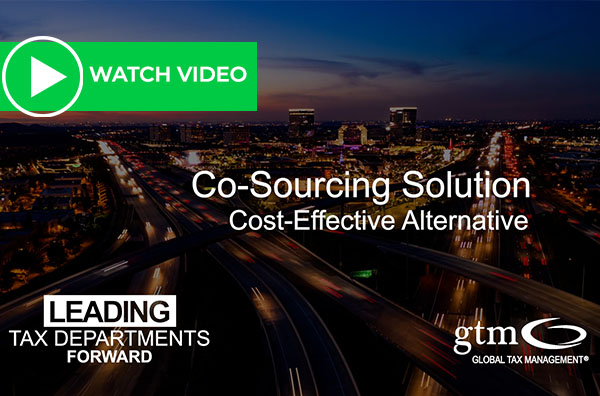The needs of a corporate tax department are constantly evolving, and the added pressure is felt by tax leaders in companies of all sizes. In our experience, we see several challenging commonalities including:
- Inadequate staffing
- The need for continuous process improvement
- The short-term and long-term impacts of new regulations
As a leader in your organization, you may relate to one or more of these. The common thread among these challenges is keeping up with all these requirements within the constraints of your budget. The good news is that operational efficiencies can be achieved. Here are three key strategies to consider that can bring operational and cost efficiencies to your department model.
Strategy #1
Bolster Your Tax Team Structure Through Co-Sourcing
As corporate tax departments adjust to a continually complex environment, their roles are changing. Tax departments are not only expected to interpret, model, quantify and report the impact of new and changing regulations, but are also expected to anticipate the future impact of hypothetical law changes brought about by expected events (e.g. the US Presidential Election). Such events can quickly change the necessary skillsets of a tax function between operations and planning. In a very competitive job market, tax leaders need to develop a flexible operating model that can quickly augment resource gaps.
Tax leaders may find themselves in a position to reprioritize their staff to focus on the requests of management, putting traditional operations such as provision and compliance aside. In addition, tax leaders may find that shifting the focus of their personnel may not meet the core competencies of their current team and are thus in the need for a “just-in-time” resource augmentation to fill in the gaps. This is where co-sourcing can be an effective solution.
Tax leaders can leverage effective co-sourcing to lead, augment and/or support any situation where client resources must be reprioritized or redirected to meet management goals. This can come in the form of experienced resources to pick up operational requirements such as provision and compliance. Alternatively, if the department’s core competencies are better focused on its current operational responsibilities, an effective co-source arrangement can strategically work with department leadership to interpret, model and execute on planning strategies while still incorporating outputs into operational results (e.g. cash tax modeling, ETR forecasting, etc.).
An effective co-sourcing arrangement can fill the gaps caused by high seasonal demand (e.g. year-end provision, tax compliance,) staff augmentation (e.g. due to turnover or expansion,) and short-term needs where experience counts (e.g. tax reform modeling). In addition, the by-product of an effective co-source model allows tax leaders real-time, continuous access to knowledgeable specialists to act as a sounding board and to provide foresight into future opportunities, risk mitigation and process improvement. An effective co-source can also incorporate into “Strategy 3” below.
Learn more about Co-Sourcing with GTM.
Strategy #2
Maximize Your Tax Technology Stack
When considering the needs of a strong tax department, one thing is clear: companies must adopt and master the use of tax technology. Whether its regulatory reporting (e.g. 10-K), modeling (e.g. tax reform, impacts of a presidential election,) or compliance with tax authorities (e.g. IRS, OECD, etc.), technology plays a key role in how companies compile, compute, analyze, and report on crucial data. The ability to adapt models, draw comparisons, perform analytics, and effectively communicate through data visualization has quickly shifted from a “nice to have” to a “must have.” This requires the integration of tax software, data management, BI tools, and collaboration technologies in ways that effectively transform raw data, perform precise calculations, and create meaningful outputs for easy end-user interaction and understanding.
There are endless solutions to choose from, from current market leaders to emerging powerhouses. Fully leveraging your tax technology investment requires the following steps:
- Build a core tax technology strategy. Start by examining and documenting your existing tax technology stack including your tax and financial software, data and BI applications, and your collaboration platforms. Then, identify where your business and tax department are going in the next three years. Think about challenges that are presented to the department today and ones that will arise based on where you are going. Evaluate your current technology stack against those existing challenges and future needs.
- Execute your tax technology strategy. Once you’ve established your core tax technology strategy and answered the questions above, you must execute on it. That starts by selecting the most important needs as well as evaluating the technology (or technologies) that best handles them. When addressing key pain points, look at each identified item as part of a larger process. The key is to determine which solutions will deliver the most value for you overall.
- Regularly Revisit and Analyze Your Tax Technology Approach. There is no such thing as a one-size-fits-all tax technology solution for the long-term. Tax department needs and technology change too quickly. Periodic review of your overall tax technology approach ensures that it remains aligned with business needs and the scope of the corporate tax department’s functions. As further changes in business needs transpire, subsequent adjustments to the overall game plan may be necessary to effectively support the business. Lastly, you want to make sure your technology investment is being fully utilized as your department lifecycle evolves through promotion, turnover and succession.
Learn 3 Tips for Leveraging Your Tax Technology Stack.
Strategy #3
Leverage Precision Expertise
There will be times when your tax department needs extra support in just one or two areas, without the commitment of a full-time, internal resource. These can include technology services, planning ideas, interim resources, or assistance with special projects – all designed to enhance your day-to-day core operations with a fresh perspective and skill set. Based on your current tax talent and department structure, look for gaps in the following that can be filled with knowledgeable tax professionals:
- Tax Automation/Technology Implementation/Administration. Selecting, implementing, and enhancing your tech stack, as noted above, may not be something your current tax team can manage on its own. In addition, companies may have a strong operational base upon implementation but may struggle to properly administrate to their technology investments thus diminishing the effectiveness in the long term. Look for specialists who combine automation experience and tax technical expertise to assist with process design, implementation, upgrades, optimization, and maintenance.
- Tax Consulting and Planning. Look for specialists who possess the depth of technical expertise to uncover tax savings opportunities, mitigate risk, and/or apply complex tax law changes to your specific situation and entity structure. Some of the most beneficial areas where outside expertise can be leveraged include international tax planning (e.g. continued impacts of US tax reform), property tax, state and local tax (e.g. impacts of work-from-home), transfer pricing, R&D tax credit, and tax depreciation.
- Interim Resources. The loss of key internal tax personnel, including tax department leadership, can put companies at risk of not meeting critical obligations. Look for a partner who can provide experienced tax professionals at all levels including specialty areas to carry the department during times of transition for as long as needed.
If we learned anything over the last several years, it has been that nothing stays constant. Business expansion brings added workload for your team. New regulations mean figuring out how to apply them accurately. And keeping pace with technology can be a full-time job in and of itself. Employing one or more of the strategies above can provide immediate impact, for the wellbeing of both your team and your bottom line.
Contact us to learn more.



